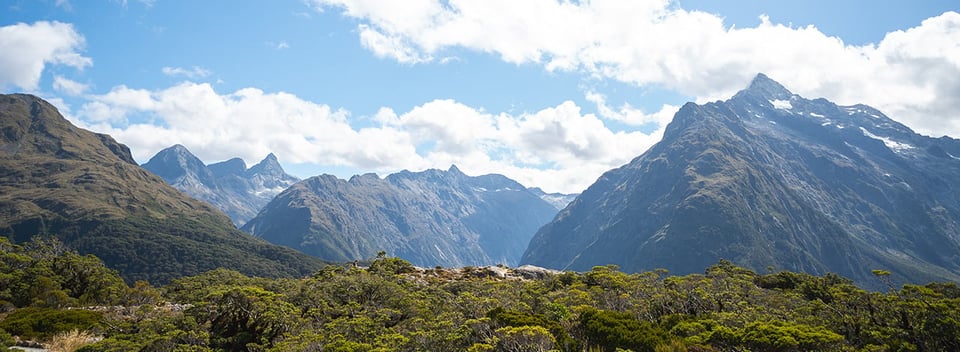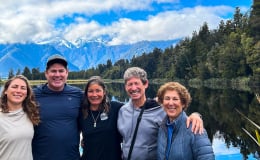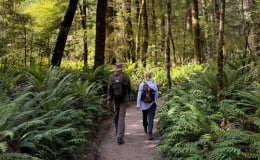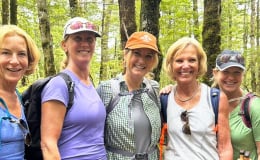
New Zealand National Parks | A Complete Guide

In this article:
1. How many national parks are there in New Zealand? 2. New Zealand national parks – a little background 3. 1. Arthur's Pass National Park 4. 2. Paparoa National Park 5. 3. Westland Tai Poutini National Park 6. 4. Mount Aspiring National Park 7. 5. Fiordland National Park 8. 6. Mount Cook National Park 9. 7. Tongariro National Park 10. 8. Egmont National Park 11. 9. Whanganui National Park 12. 10. Abel Tasman National Park 13. 11. Kahurangi National Park 14. 12. Nelson Lakes National Park 15. 13. Rakiura National ParkHow many national parks are there in New Zealand?
There are 13 national parks in New Zealand; three in the North Island and 10 in the South. These vast wilderness areas are home to New Zealand’s most breath-taking scenery – from lush rainforests to rugged alpine passes, our national parks represent the very best of New Zealand’s landscape.
If, like many visitors, your time in New Zealand is limited, how do you choose which to visit? Luckily we’ve done the hard work for you, leaning on our decades of experience showcasing the very best of our country on our all-inclusive New Zealand hiking tours, and chosen six of the best national parks in New Zealand to help with your decision!*
*If we’re being honest, all the national parks in New Zealand are incredible so we’ve included the best of the rest (i.e. all of them) below our top 6 as well!
New Zealand national parks – a little background
New Zealand national parks are made up of publicly owned areas of land, protected for scenic, environmental, scientific, historical and cultural reasons, or simply just for the enjoyment of locals and visitors. The Department of Conservation (a government administered organisation), looks after our national parks and ensures that these treasured wilderness areas are protected for generations to come.
In a country that has a reputation for stunning scenery, it’s not surprising that 30% of New Zealand’s total area is made up of national park. They come in all shapes and sizes, with the largest being Fiordland National Park and the smallest, Abel Tasman National Park. The oldest is Tongariro National Park (established in 1887) and the youngest is Rakiura National Park (Stewart Island, established in 2002).

Download the New Zealand National Parks map here
National parks in New Zealand are spread across the country, with a greater concentration in the stunning South Island. You’ll find six of our favourites here, dotted around the south and west of the South Island. They are:
- Arthur’s Pass National Park
- Paparoa National Park
- Westland Tai Poutini National Park
- Mount Aspiring National Park
- Fiordland National Park
- Mount Cook National Park
Read on for a quick guide to best national parks in New Zealand, as well as an overview of all the rest too.
The best national parks in New Zealand
1. Arthur's Pass National Park

Exploring Arthur's Pass National Park - one of the best national parks in New Zealand.
Resting on the backbone of the Southern Alps and the closest to the South Island's largest city Christchurch, Arthur's Pass National Park is named after Arthur Dudley Dobson, the explorer who discovered the pass linking Canterbury to the West Coast.
Arthur's Pass National Park was established in 1929 and is the South Island's oldest national park. Unique features include New Zealand's only true alpine village. It's also the only national park in the South Island accessible by train (the world-famous TranzAlpine, which we highly recommend!) and every year in February the park plays host to the Coast to Coast adventure race. Our top picks in the area include the TranzAlpine train, hiking the Bealey Valley and Oscar's Haus in the village.
2. Paparoa National Park
Paparoa is one of our newer and smaller national parks in New Zealand (established in 1987) and is only 30,600 hectares (75,600 acres) in size. Paparoa National Park stretches from the Tasman Sea to the lush green Paparoa Ranges. With tropical-looking forest and white sandy beaches, it's very different from the alpine world of Arthur's Pass National Park, but as it is only a few hours away, you can visit both in one day.
The geology is the most unique aspect of Paparoa National Park; it’s made from predominantly limestone karst rock which has created a vast array of underground caves and caverns. Experienced cavers can explore on their own through the vast network of cave systems or for those who would like the security of a guided tour, the Nile River glow worm caves are very accessible and something you’ll remember forever!
The best place to stay to explore Paparoa is the idyllic seaside village of Punakaiki, home of the Pancake Rocks and blowholes. Spend time in the glorious Punakaiki Paparoa National Park on our incredible Masterpiece trip!

Punakaiki pancake rocks, West Coast New Zealand
3. Westland Tai Poutini National Park
The Westland Tai Poutini National Park was established in 1960 and had 4,400 hectares (11,000 acres) added in 2010 to make a total current area of 130,00 hectares (325,000 acres). It’s an incredibly varied landscape that stretches from New Zealand's highest peaks, through lush rainforest down to rugged and remote coastline.
The western slopes of the Southern Alps are home to the most accessible of New Zealand's glaciers - Franz Joseph and Fox Glacier. This is the only place in New Zealand where you can actually walk out on a glacier even if you don't have any mountaineering experience - it's easy and safe with a guide. Other highlights in Westland Tai Poutini National Park are kayaking the serene Okarito Lagoon and admiring the mountain reflections on Lake Matheson.

Incredible views in all the New Zealand national parks, like Lake Matheson in Westland Tai Poutini National Park.
4. Mount Aspiring National Park
Our third-largest national park at 355,000 hectares (877,000 acres), Mount Aspiring National Park was established in 1964. It takes its name from the highest mountain outside of the Mt Cook region, Mount Aspiring (3033m / 9950 ft), which is visible and accessible from the Lake Wanaka side of the park.
A truly impressive natural environment, there are over 100 glaciers inside the park! Mount Aspiring National Park borders on the wilderness of Fiordland and is one of the least developed national parks in the country. Dotted with lakes both large and small, there are some stunning drives through the park and some even better walking tracks, including the Routeburn Track. For an even more spectacular way to explore, take a scenic flight over the breathtaking Mount Aspiring National Park landscape – an adventure you’ll remember for years to come!
The best bases to explore Mount Aspiring National Park from are Queenstown and Wanaka. Our Pure South tour will get you right to the heart of this incredible area.

Mount Aspiring National Park is just one of the national parks in New Zealand with some amazing walking tracks.
5. Fiordland National Park
The largest and most famous of our parks and the last real great wilderness in New Zealand - Fiordland National Park is 1.25 million hectares (3 million acres) of natural wonderland, protected since 1952. The name comes from the 14 fiords on the coast at the western extreme of the park, the most famous of which is Milford Sound. There is relatively easy access to Milford Sound, Lake Manapouri, Lake Te Anau and Doubtful Sound through existing transport links and services.
If you enjoy stretching your legs on the trail, Fiordland National Park hiking is second to none. Fiordland National Park New Zealand is home to our most famous Great Walk and possibly the finest walk in the world, the Milford Track.
For those who want to get further off the beaten track with their Fiordland National Park hiking adventure, there are places like the Hollyford Valley, Dusky Sound or the Waihauriri River to explore. Fiordland National Park New Zealand offers some great wildlife experiences and is home to iconic native species like the Kea, Kiwi and Takahe.
With so many amazing Fiordland spots, it's hard to pick a favourite, but we'll say Martins Bay at the end of the Hollyford Track - it's like the edge of the world here and the seal colony at Long Reef has to be one of the best natural wildlife experiences anywhere in the world.
Combine incredible experiences, laid-back luxury and world-class Fiordland National Park hiking on our World Heritage Walking Tour.

Milford Sound in the Fiordland National Park is truly breathtaking.
6. Mount Cook National Park
Aoraki Mount Cook National Park, a true alpine national park and home to all bar one, of New Zealand's peaks over 3000 metres (10,000 feet), including of course the highest of all, Aoraki Mount Cook. Part of the land that makes up the Mount Cook National Park has been protected from as early as 1887, although full national park status for this 71,000-hectare (175,000 acre) area wasn’t established until 1953.
There is only one way in and out of Aoraki Mount Cook National Park, a scenic road that leads you to Mt Cook Village. Surrounded by towering peaks and impressive glaciers, even short-day hikes here take on an intrepid feel.
Both the Aoraki Mount Cook National Park Visitor Centre and Sir Edmund Hillary Alpine Centre offer excellent glimpses into the world of mountaineering and are highly recommended, as are day hikes on the many well-maintained tracks leaving right from the village. Some of our favourite New Zealand day hikes can be found in Mount Cook National Park!

Statue of a young Sir Edmund Hilary gazing up at the mountains in the Aoraki/Mount Cook National Park.
Explore the best national parks in New Zealand in one amazing trip
There aren't many places in the world that offer such easy access to World Heritage Area wilderness and different national parks. As passionate locals we love nothing more than sharing our National Parks with our guests and this is exactly what we do on our fully guided New Zealand hiking tours. From the astonishing, jagged peaks of Aoraki/Mt Cook National Park to the lush native forest and tumbling waterfalls of Fiordland, we've made it our mission to show our guests the real New Zealand.
With our expert local guides at the helm we'll show you not only the most iconic attractions New Zealand is famous for, but off the beaten track hidden gems too that only a local would know. Jump in a chopper to Luxmore Hut and explore the alpine beauty of the Kepler Track, fly into Siberia Valley in a bush plane - landing in a remote wilderness paradise to explore by foot, hike our Great Walks including the Routeburn and Milford Tracks and cruise through Milford Sounds unparalleled beauty...these are just a handful of the experiences we've put together for our hiking and adventure tours.
But wait…there’s more!
Aside from the six stunning New Zealand national parks we’ve covered above, there are another SEVEN national parks in New Zealand, equally beautiful and surprisingly diverse. If you want to discover them all, read on for an overview. We’ve worked our way geographically down the country, excluding the national parks already listed above.
7. Tongariro National Park
Tongariro National Park is New Zealand’s first and oldest national park, established in 1887. It boasts dual World Heritage status in recognition of the area’s cultural and spiritual importance to the Maori people, as well as its incredible volcanic landscape. Over time the area of the national park has increased to its present size of 79,596 hectares (196,686 acres).

With dramatic views in every direction, hiking the Tongariro National Park is certainly a bucket list item.
The national park is centred around three active volcanoes on the North Island; Tongariro, Ngauruhoe and Ruapehu, which still puff and steam, contributing to the otherworldly feeling of the area. These dominant peaks have a rich Maori history which you’ll enjoy learning about as you tread the various tracks and trails that cross this strangely beautiful landscape.
While there’s a ski area on Ruapehu, Tongariro National Park is more popular during the summer months with hikers and visitors keen to experience what it’s like to walk on an active volcano! Passing turquoise-coloured alpine lakes and steaming vents, the Tongariro Crossing is known as ‘the best day walk in the world’ and one you’ll want to include on your New Zealand bucket list.
You can hike the Tongariro Crossing with us on our Sweet North tour.
8. Egmont National Park
Located on the western coast of the North Island, Egmont National Park is one of New Zealand’s most accessible national parks, with three road entry points making it easy to reach and explore. Established in 1900, it encompasses three volcano cones, the highest of which is Mount Taranaki at 2518m (8261ft).
As one of the world’s most symmetrical mountains, Mount Taranaki is a very distinctive landmark of Egmont National Park. Its summit is sacred to the local iwi (Maori people) and its cultural significance as well as imposing shadow, is felt throughout the park.

Stand before these beautiful giants in Egmont National Park.
It’s a popular destination for walkers and hikers, as well as local hunters, and there is a small club field for skiing over the winter months. For experienced hikers, the challenging ‘Around the Mountain Circuit’ can be completed in 4 to 5 days, with plenty of shorter day hikes available as well.
Dawson Falls is a great spot for a dip on hot summer days, while the Wilkies Pools close by were formed by 20,000-year old lava! Nestled amongst the subalpine forest, there are tracks and trails suitable for all abilities and ages.
9. Whanganui National Park
Neighbouring Egmont, the Whanganui National Park has a unique history of human settlement. The early Maori people used the Whanganui River to trade and communicate among themselves, building pa (villages), marae (meeting grounds) and weirs along the banks. There are many sacred sites and landscape features along the river and traditional customs are still observed at these places today.
Established in 1986, the Whanganui National Park protects one of the largest remaining areas of lowland forest on the North Island and provides a safe habitat for a variety of native wildlife. The winding Whanganui River is the country’s longest navigable river and flows through the heart of the national park from the mountains to Tasman Sea.

The mighty Whanganui River in Whanganui National Park, the only Great Walk that isn't a walk!
Home to the only Great Walk that isn’t actually a walk, the Whanganui Journey is a three or five-day river journey which you can paddle by kayak or canoe – a great way to enjoy this beautiful landscape! Various side trips and walks along the way will provide you with an insight into the national park’s history as well as today’s conservation efforts and activities.
10. Abel Tasman National Park
Known for its golden sand beaches, granite cliffs, lush greenery, mild climate and world-class coastal hiking, the Abel Tasman National Park is a sparkling jewel at the top of the South Island. At only 22,530 hectares (55,673 acres) in size, it’s the smallest of New Zealand’s national parks, but certainly packs a punch in terms of scenery!

At New Zealand Trails, our favourite way to enjoy Abel Tasman National Park is by sea kayak.
Back in 1642, the Dutch seafarer Abel Tasman became the first European to set foot on New Zealand soil, anchoring his ships in Golden Bay. He didn’t stay long though – an incident with the local Maori people who had been in residence along the coast for some 500 years led to violence and a rapid departure. Despite that unfortunate event, some 300 years later in 1942, the area was protected by the Government and named the Abel Tasman National Park.
The area is easily accessible, with the closest towns being Motueka, Takaka and Kaiteriteri. The Abel Tasman Coast Track is one of New Zealand’s famous Great Walks – you can walk the whole length or take a water taxi or kayak to different points along the way.
Our favourite way to explore the clear waters, calm coves and secluded beaches of the Abel Tasman National Park is by sea kayak. Enjoy your own kayaking adventure on our Kiwi Classic tour or spend time in the exploring the National Park by foot on The Grand Explorer.
11. Kahurangi National Park
Situated in the northwest corner of the South Island, the Kahurangi National Park is New Zealand’s second-largest national park at 452,002 hectares (111,6921 acres) in size. It’s also one of our younger national parks, established in 1996.
The word ‘Kahurangi’ when translated has various meanings, one of which is ‘treasured possession’ – an appropriate name for this incredibly diverse area. Spanning mountains to marshland and forest to coast, the Kahurangi National Park is home to a variety of native wildlife, including the great spotted kiwi and weta (a flightless insect that looks a bit like a grasshopper).

Incredible views from the Mt Arthur Range in Kahurangi National Park.
Motueka and Takaka are the best towns to access the park, with the Heaphy Track a popular drawcard for hikers over the summer months and mountain bikers over winter (from May to November). Find out which season suits you best here!
Aside from hiking or biking the 78.4km (48.7 miles) Heaphy Track (one of the 10 Great Walks of NZ), there are lots of things for visitors to do in the Kahurangi National Park – camping, wildlife watching, caving, fishing, kayaking and rafting, to mention just a few. As a close neighbour to both Abel Tasman and Nelson Lakes National Parks, you could combine a visit, although be sure to have a read of this article before you make any plans - What is the best way to travel New Zealand?
12. Nelson Lakes National Park
Nelson Lakes National Park has a special place in our hearts here at New Zealand Trails. Located at the top of the South Island, an hour’s drive from Nelson, it covers some 102,000 hectares (252,047 acres) of beautiful wilderness. Established in 1956, it’s a little further off the beaten track than other national parks in New Zealand, but we reckon it’s well worth the effort it takes to get there.

You'll be hard-pressed to take photos that scream 'I earned this' more than above Nelson Lakes National Park - without going on a week-long mission, of course.
The Angelus Circuit is our favourite hike in the Nelson Lakes National Park. It’s a 3-day/2-night hike that takes you up to the stunningly situated Angelus Hut at 1650m (5413ft) nestled in the clouds on the ranges between Lake Rotoiti and Rotoroa, before a challenging hike along Robert’s Ridge and down to the lakes below for a well-deserved drink and tasty dinner!
There are lots of different tramping trails throughout the park, with some routes weather dependant and many tracks for advanced hikers only. We recommend that you hike with an experienced New Zealand guide to make the most of this beautiful environment. You can hike the Angelus Circuit with us on our Kiwi Classic adventure.
13. Rakiura National Park
Located on the remote Stewart Island, 25.5km (15.8 miles) off the mainland at the bottom of the South Island, Rakiura National Park is both wild and beautiful. New Zealand’s most recent national park, established in 2002, its 157,000 hectares (387,955 acres) covers some 85% of Stewart Island’s total area.

It can be what we Kiwis call 'a wee bit chilly' down in Rakiura National Park, but it's a truly beautiful visit nonetheless.
Made up of secluded beaches, pristine coastal forests and sheltered coves, it’s a fantastic destination for hikers and home to another of our Great Walks, the Rakiura Track. To get across to Stewart Island you’ll need to take a 20-minute flight from Invercargill or a one-hour boat trip from Bluff. The weather can be quite unpredictable in this part of the country, so be sure to follow our packing advice for an enjoyable trip!
Rakiura National Park is something of a wildlife haven with many native birds finding sanctuary here. It offers one of the best opportunities in the world to spot our national icon, the kiwi bird, in its natural habitat. Kiwi are nocturnal, so prepare for some long nights if you’re keen to see one in the wild!
Which will you choose?
So now we’ve led you through all 13 New Zealand national parks, the choice is yours! Discover some of these national parks on our New Zealand guided hiking trips, or get in touch with us to find out more about including the best national parks in New Zealand in your travel plans!
Other articles you may like:
- Fiordland National Park
- Mt Aspiring National Park
- The 10 New Zealand Great Walks
- What's the best time for hiking in New Zealand?
- Request a free copy of our brochure







